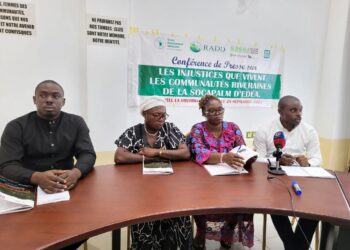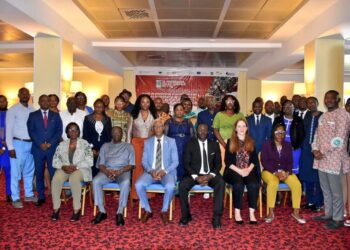
Voice by Louvier Kindo Tombe
Read Full Article by Clicking Here
July 22, 2023 – it is a wet Friday evening in Bonaberi, Douala, Cameroon’s largest city, and the air is filled with music and chants. “Small thing pick am, small thing pick am”, a group of young people sing along to a catchy tune that sounds familiar but different. The chant is from Earthsong’, a retouch of the ‘Newsman’ song by Wams, a popular Cameroonian artist who is known for his environmental activism.
Wams Klassic, born Anjianjei Constantine, is Green Music Ambassador for Cameroon – Africa, founder of Creative Artists for Nature and Sustainable Development, CANSUD. His original version of the song, released in 2017, was a call for press freedom and solidarity. The new version, dubbed the ‘Earthsong’, is a call for climate action and sustainability.
Unfortunately, many are they that deny the reality and consequences of climate change. According to a 2020 study, 5% of Germans don’t believe in Global Warming. The figure rises to 9% in the United States of America. In a country with less internet penetration rate, less literacy and sensitization like Cameroon, the figure is likely to be higher. Many too, have never even heard of climate change.
It is for this reason that CANSUD and volunteers decided to take the word to as many as possible, using their creative works.
Wams is the star of the show at the Climate Clock event, a global initiative that aims to raise awareness and mobilize people to fight climate change. He is joined by other talented artists who use rap, spoken word, and other forms of art to convey their messages. The crowd is thrilled by their performances, but also inspired by their passion and commitment.
But this is not just a concert. It is also a campaign. Their performance marked five years of the Climate Clock – a countdown to the estimated time left to limit global warming to 1.5 degrees Celsius above pre-industrial levels, according to the Paris Agreement.
Before hitting the stage, Wams and his fellow artists teamed up with a diverse group of young volunteers to spread the word about climate change across the city. They visited markets, streets, and neighborhoods, engaging with people and educating them about the causes and consequences of global warming. They also encouraged them to take action and join the movement for a greener and cleaner future.
“It is very innovative. Normally people would use the media and social media to do this but it takes a real heart to go on the streets and meet strangers and talk to them and advise them about the environment and why it is important for them to cater for their environment,” says Mac Alunge, a spoken word artist and performer at the concert.
The campaign targeted a range of aspects including misinformation and ignorance on climate change and its adverse effects on the environment. Describing his performance as artvocacy for earth, Alunge says “the climate crisis we are facing has never been a greater emergency than now and so it is very timely, needed, important and relevant for us to step up”.
His only regret, the performer notes, is that “not much of the population could be reached.”
Douala: Cameroon’s ‘waste capital’
The choice of Douala as venue for the activities was not random. Home to over 4 million people, climate change is affecting Douala in various ways, such as increasing the frequency and intensity of floods, droughts, heat waves, and storms. Studies hold that annually, an average of 5 to 10 floods occur in Douala, with the average of one death for every flood incident. In September 2019, heavy rains caused floods that killed four people and displaced thousands of others in several neighborhoods of the city.
Slightly over a year later, in August 2020, a series of flooding events affected nearly 2,210 buildings and 12,376 victims spread over 82 hectares in the Makèpè Missokè neighborhood. The maximum inundation level, a study showed, was 4.48 m and the flow velocity was less than 1 m/s.
But that is just one of the many problems that come with a big city like Douala. The flooding is exacerbated by poor waste disposal and the hazards it poses. Home to a majority of Cameroon’s biggest industries, waste disposal in the town is a major challenge, one activists say is not adequately checked by the powers that be.
“Government is doing quite well. It is taking concrete measures to address the climate emergency but it is not enough. There is more it can do, especially the city of Douala is really a climate impact site impacted by floods, poor waste disposal. Deforestation is also an issue,” Wams notes.
Generous heaps can be found in multiple street corners and in streams across the city. Most of it is comprised of non-biodegradable plastic items – subject of the #ActInTime initiative.
Government action
To reduce the risk and impact of floods in Douala, several measures have been proposed or implemented by the government, the municipalities, and other stakeholders. These include improving flood forecasting and early warning systems, enhancing urban planning and land use regulation, upgrading drainage networks and integrating climate and disaster risk considerations into development planning and investments.
The subject too has been on the lips of parliament for a long time. The institution at its sessions, discussed the implementation of the Paris Agreement on climate change, which Cameroon ratified in 2016. The parliamentarians expressed their concerns about the gaps and challenges in fulfilling the country’s commitments under the agreement, such as reducing greenhouse gas emissions, enhancing resilience to climate impacts, and mobilizing financial and technical support. They also called for more coordination and collaboration among different stakeholders, such as ministries, local authorities, civil society, and development partners2
The parliament too hosted a workshop on climate change and security in the Lake Chad Basin, which is shared by Cameroon, Chad, Niger, and Nigeria. The workshop aimed to raise awareness and foster dialogue among parliamentarians on the linkages between climate change and security issues in the region, such as violent extremism, intercommunal conflicts, displacement, and humanitarian crises.
What future ?
But activists hold that these measures are limited and their results slow in coming.
One of the major weaknesses in their approach, Wams believes, is taking action without consulting the population. “They should not act without consulting the population,” he warns.
“In a flood-prone city like Douala the population is expecting the government to build more sandbanks to prevent water from overflowing their course. They are expecting the government to provide many more waste dump facilities closer to them, multiply waste disposal companies, build more recycling companies. [But] most times, authorities implement solutions without understanding them.”
Fongoh Eric, Founder of the International Center for Environmental Education and Community Development (ICENECDEV) holds a similar view. Based in the seaside town of Limbe, an 80KM drive from Douala, the challenges are similar and the response should be adequate.
He thinks the Ministry of Environment together with other ministries like the Ministry of Town Planning and the local government or City Council, should make available and publicise a blueprint to address the issue of environmental risks and hazard along the West Coast of Cameroon and in the in the entire country. “There should be some sort of an emergency plan also for the intervention with the situation that we are facing now in the southwest region… policy framework to address environmental risk is not accessible,” he asserts.
The World Bank report warns that climate change could have severe consequences for Cameroon’s development and well-being. By 2050, the country could lose 4.5% of its GDP and see a 12% rise in poverty due to the impacts of global warming. The report also highlights the sectors that are most at risk from climate change, such as agriculture, water resources, health, and energy.
Fongoh thinks “there is an urgent need for that multi stakeholder collaboration and partnership between the Ministry of Environment, the environment, civil society organization, the Ministry of Town Planning and Urban Development.”
Other actors might think the same, but results on the field are not forthcoming as the situation at hand warrants. To avoid this scenario, Cameroon needs to act urgently and collaboratively. Activists, government authorities and the population must work together to find solutions that protect the environment and the people.
While hoping more is done, Wams, Alunge and friends can only keep using what they have, art, to do the most they can. CANSUD has received the emblematic Climate Clock and is implementing its mandate in Cameroon. But this like other individual actions can only go so far. The climate clock is ticking.
Giyo Ndzi
Read Full Article by Clicking Here








